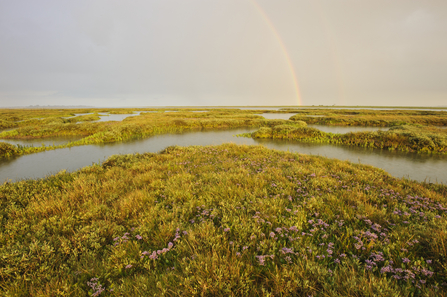Saltmarshes are the unsung heroes of our coast. Not only do they support a huge biodiversity – from tiny critters within the mud, fishes in the creeks, to birds on the shore; they also support and protect us – and are one of our key allies in fighting the climate crisis. They deserve our recognition, respect, and protection.
A distinctive feature of estuaries, these changeable habitats are regularly flooded by the tide and are made up of unique, salt-tolerant plants. It is the roots of this highly adapted vegetation that bind the precious mud and creates semi-sheltered areas. The twists and turns of saltmarsh channels act as fish nursery areas, allowing juvenile fish to find refuge and feed – and predatory fish to hunt! These fish go on to support the biodiversity of the wider seas.
Not only do these muddy habitats protect us from coastal erosion and storm surges, but they also help us combat climate change. The Wildlife Trusts’ recent ‘Let nature help’ report champions this often underappreciated yet essential habitat – one hectare of saltmarsh can capture two tonnes of carbon a year and lock it into sediments for centuries!
However, in the UK we are losing nearly 100 hectares of saltmarsh a year due to a combination of threats including sea level rise, development, an increase in storm surges and eutrophication. Despite being an iconic part of the Essex coastline, over 60% of our saltmarshes have been affected by erosion over the last 20 years.


